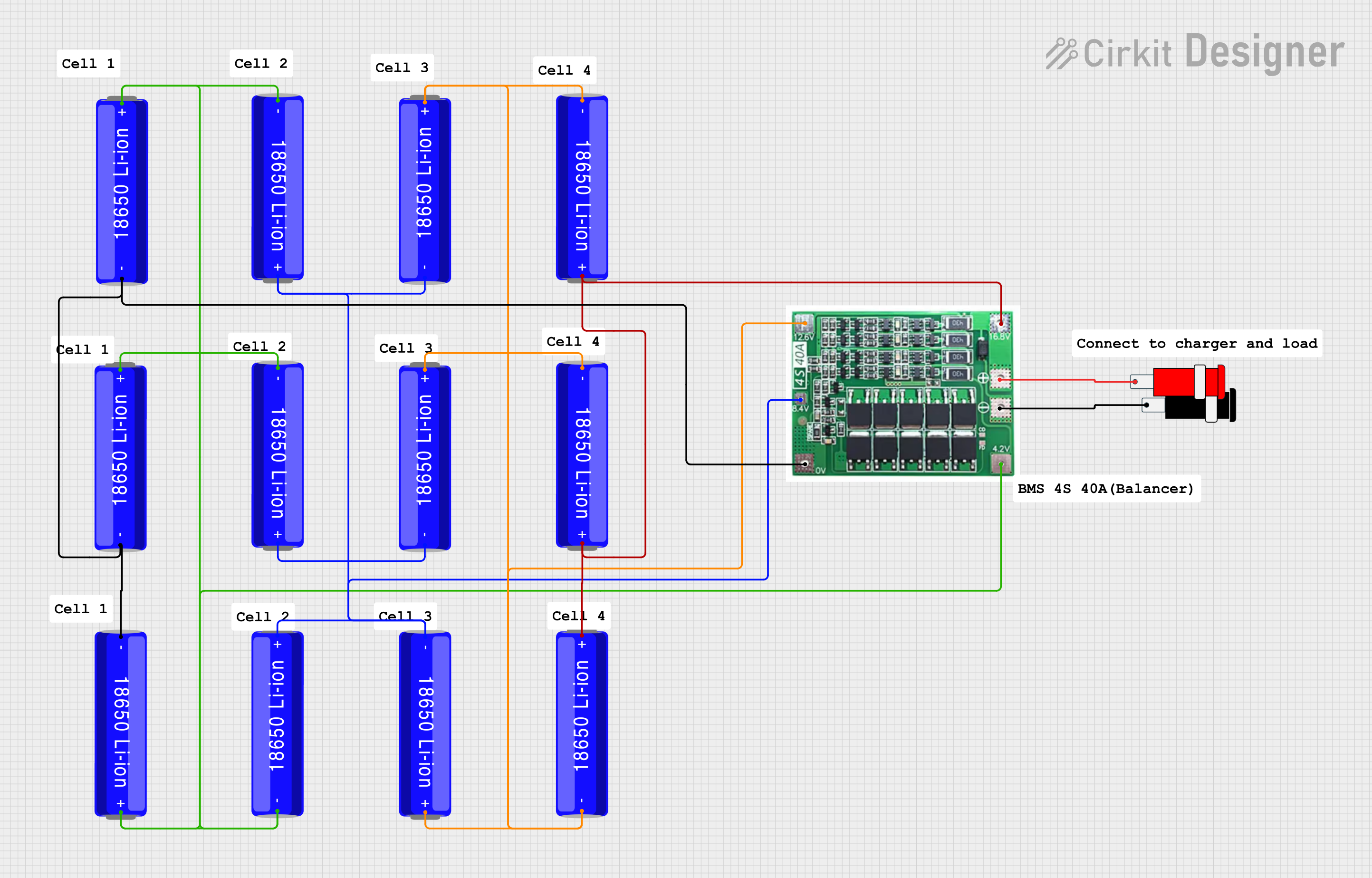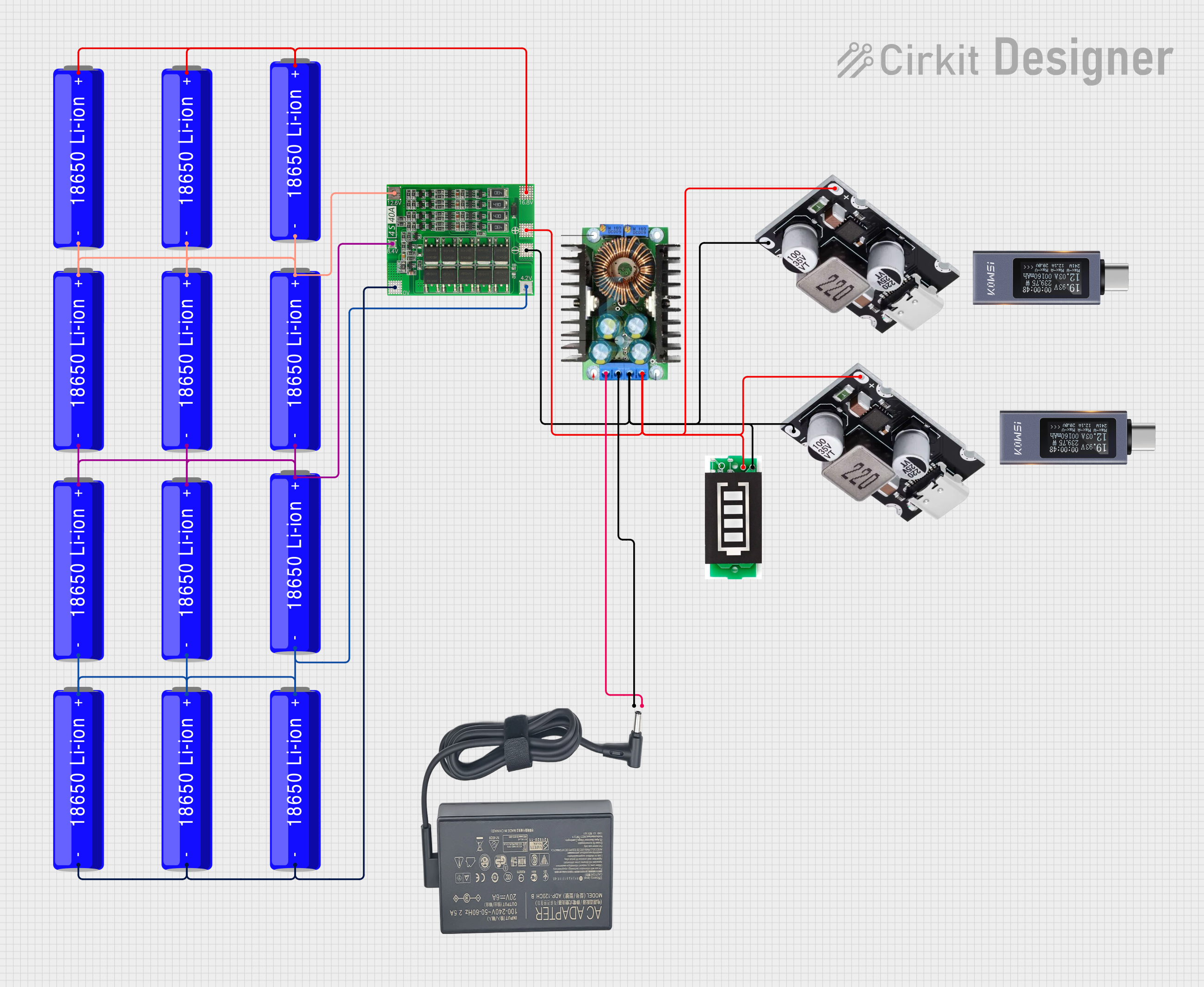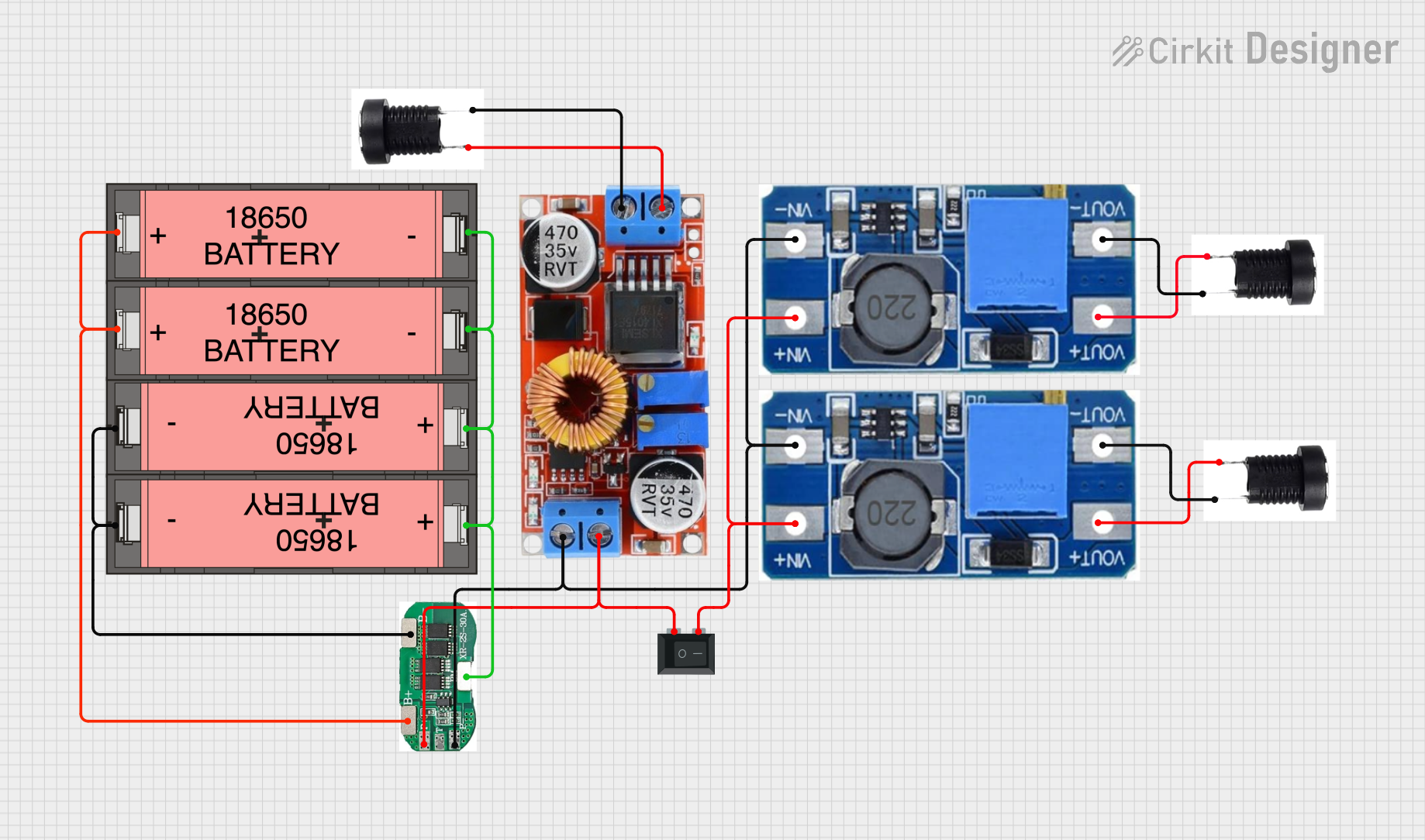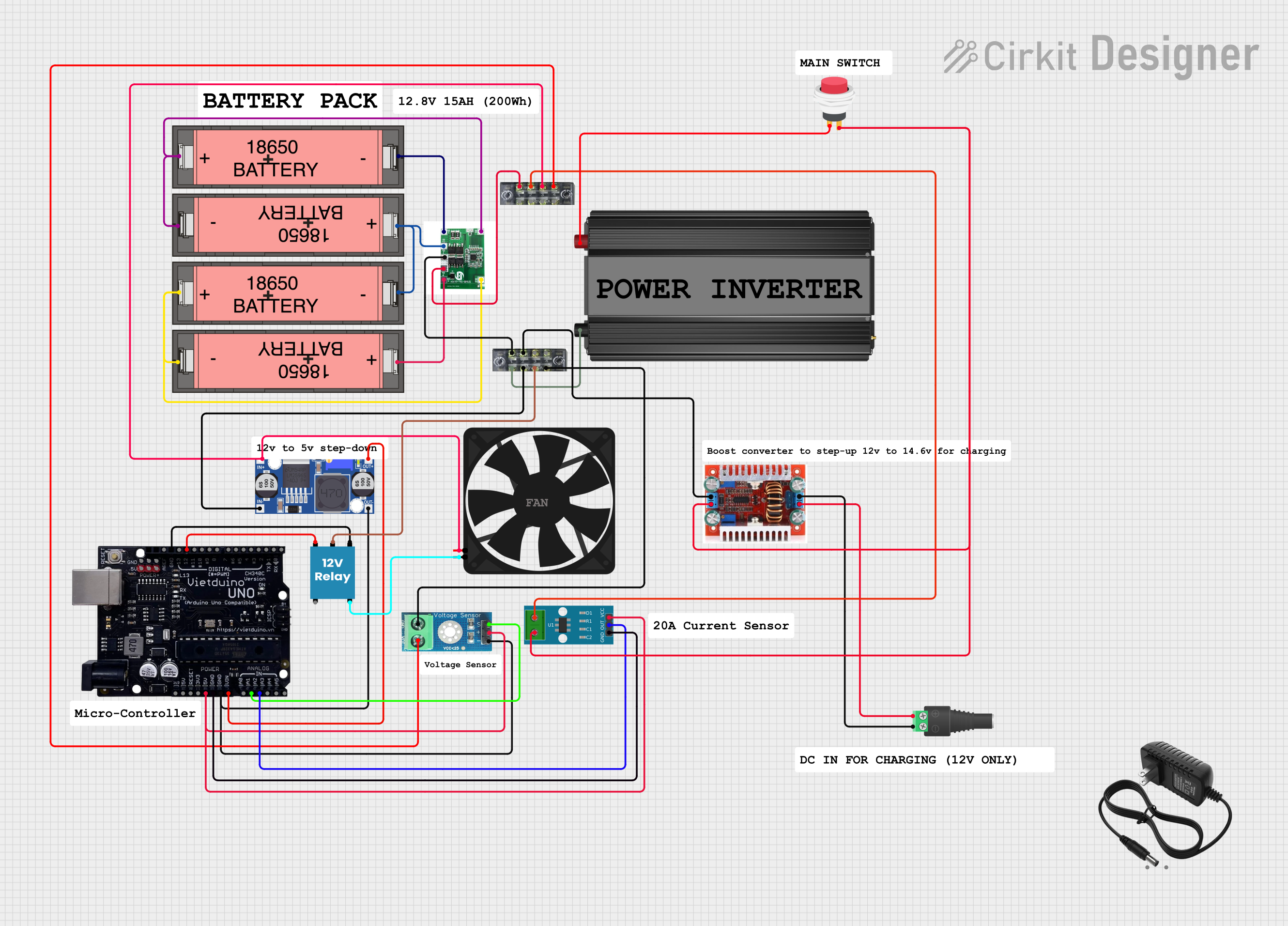
How to Use 4s 16.8v bms: Examples, Pinouts, and Specs

 Design with 4s 16.8v bms in Cirkit Designer
Design with 4s 16.8v bms in Cirkit DesignerIntroduction
The 4S 16.8V BMS (Battery Management System), part ID HX-4S-D20, is a robust and reliable component designed by Arduino for managing 4-series lithium-ion battery packs. It ensures the safe operation of battery packs by monitoring critical parameters such as voltage, current, and temperature. Additionally, it provides essential protection features, including overcharge, over-discharge, and short-circuit protection, while balancing the charge levels of individual cells.
Explore Projects Built with 4s 16.8v bms

 Open Project in Cirkit Designer
Open Project in Cirkit Designer
 Open Project in Cirkit Designer
Open Project in Cirkit Designer
 Open Project in Cirkit Designer
Open Project in Cirkit Designer
 Open Project in Cirkit Designer
Open Project in Cirkit DesignerExplore Projects Built with 4s 16.8v bms

 Open Project in Cirkit Designer
Open Project in Cirkit Designer
 Open Project in Cirkit Designer
Open Project in Cirkit Designer
 Open Project in Cirkit Designer
Open Project in Cirkit Designer
 Open Project in Cirkit Designer
Open Project in Cirkit DesignerCommon Applications and Use Cases
- Power management for electric vehicles (e-bikes, scooters, etc.)
- Energy storage systems (solar power banks, UPS systems)
- Portable electronics and DIY battery packs
- Robotics and IoT devices requiring lithium-ion battery packs
Technical Specifications
The following table outlines the key technical details of the HX-4S-D20 BMS:
| Parameter | Value |
|---|---|
| Battery Configuration | 4-series (4S) lithium-ion cells |
| Maximum Voltage | 16.8V |
| Minimum Voltage | 10V |
| Overcharge Protection | 4.25V ± 0.05V per cell |
| Over-discharge Protection | 2.7V ± 0.05V per cell |
| Maximum Continuous Current | 20A |
| Balancing Current | 60mA |
| Short Circuit Protection | Yes |
| Operating Temperature | -40°C to 85°C |
| Dimensions | 45mm x 60mm x 3mm |
Pin Configuration and Descriptions
The HX-4S-D20 BMS has the following pin configuration:
| Pin Name | Description |
|---|---|
| B+ | Positive terminal of the battery pack |
| B- | Negative terminal of the battery pack |
| P+ | Positive terminal of the load/charger |
| P- | Negative terminal of the load/charger |
| B1 | Connection to the positive terminal of the first cell in the series |
| B2 | Connection to the positive terminal of the second cell in the series |
| B3 | Connection to the positive terminal of the third cell in the series |
| B4 | Connection to the positive terminal of the fourth cell in the series |
Usage Instructions
How to Use the Component in a Circuit
Connect the Battery Pack:
- Connect the B+ and B- terminals to the positive and negative terminals of the 4-series lithium-ion battery pack, respectively.
- Connect the intermediate cell terminals (B1, B2, B3, and B4) to the corresponding positive terminals of each cell in the series.
Connect the Load/Charger:
- Attach the load or charger to the P+ and P- terminals. Ensure the load does not exceed the maximum continuous current rating of 20A.
Verify Connections:
- Double-check all connections to ensure proper polarity and secure contacts. Incorrect wiring can damage the BMS or the battery pack.
Power On:
- Once all connections are verified, the BMS will automatically begin monitoring and protecting the battery pack.
Important Considerations and Best Practices
- Cell Matching: Ensure all cells in the battery pack have similar capacities and internal resistances to avoid imbalances.
- Heat Dissipation: Avoid enclosing the BMS in a sealed environment. Provide adequate ventilation to prevent overheating.
- Avoid Overloading: Do not exceed the maximum continuous current rating of 20A to prevent damage to the BMS.
- Balancing: The BMS automatically balances the cells during charging. Allow sufficient time for balancing if the cells are significantly imbalanced.
Arduino Integration Example
The HX-4S-D20 BMS can be used with an Arduino UNO to monitor battery voltage. Below is an example code snippet to read the voltage of the battery pack using an analog input pin:
// Arduino code to monitor battery voltage using HX-4S-D20 BMS
const int voltagePin = A0; // Analog pin connected to the battery pack
const float voltageDividerRatio = 5.7; // Adjust based on your resistor divider
void setup() {
Serial.begin(9600); // Initialize serial communication
pinMode(voltagePin, INPUT); // Set the voltage pin as input
}
void loop() {
int analogValue = analogRead(voltagePin); // Read the analog value
float batteryVoltage = (analogValue * 5.0 / 1023.0) * voltageDividerRatio;
// Print the battery voltage to the Serial Monitor
Serial.print("Battery Voltage: ");
Serial.print(batteryVoltage);
Serial.println(" V");
delay(1000); // Wait for 1 second before the next reading
}
Note: Use a voltage divider circuit to step down the battery voltage to a safe range (0-5V) for the Arduino analog input pin.
Troubleshooting and FAQs
Common Issues and Solutions
BMS Not Powering On:
- Cause: Incorrect wiring or loose connections.
- Solution: Verify all connections, especially the polarity of the battery pack and load.
Overheating:
- Cause: Excessive current draw or poor ventilation.
- Solution: Ensure the load does not exceed 20A and provide adequate cooling.
Cells Not Balancing:
- Cause: Significant capacity mismatch between cells.
- Solution: Replace cells with matched capacities and internal resistances.
Short Circuit Protection Triggered:
- Cause: Accidental short circuit in the load or wiring.
- Solution: Disconnect the load, inspect the wiring, and reconnect after resolving the issue.
FAQs
Q: Can I use this BMS with a 3S battery pack?
A: No, the HX-4S-D20 is specifically designed for 4-series (4S) lithium-ion battery packs.Q: How do I know if the BMS is balancing the cells?
A: The BMS automatically balances cells during charging. You can measure individual cell voltages to confirm balancing.Q: Can I use this BMS for LiFePO4 batteries?
A: No, this BMS is designed for lithium-ion batteries with a nominal voltage of 3.7V per cell.Q: What happens if one cell is damaged?
A: Replace the damaged cell immediately to prevent imbalances and ensure safe operation.
By following this documentation, users can safely and effectively integrate the HX-4S-D20 BMS into their projects.